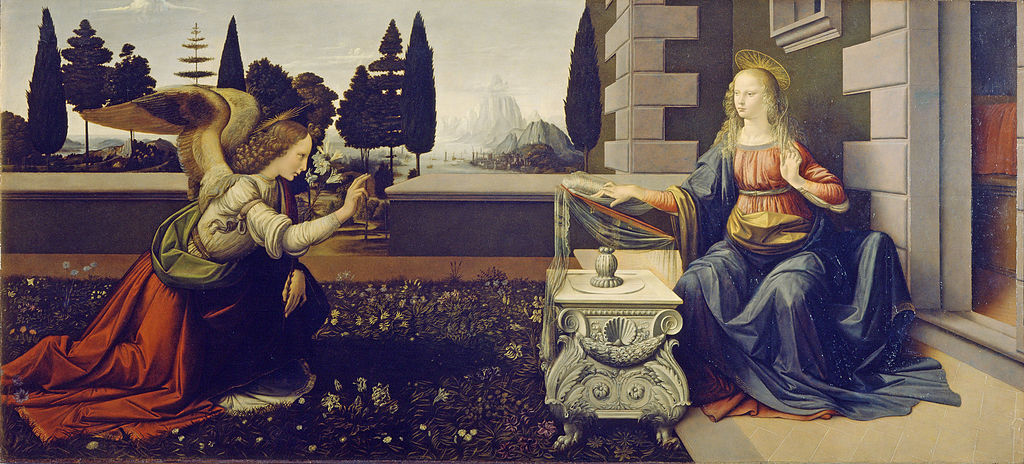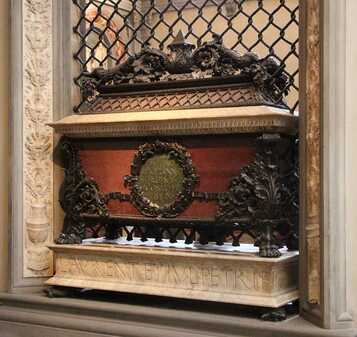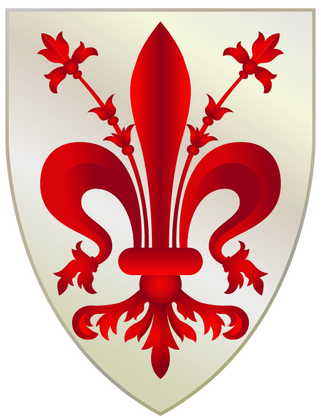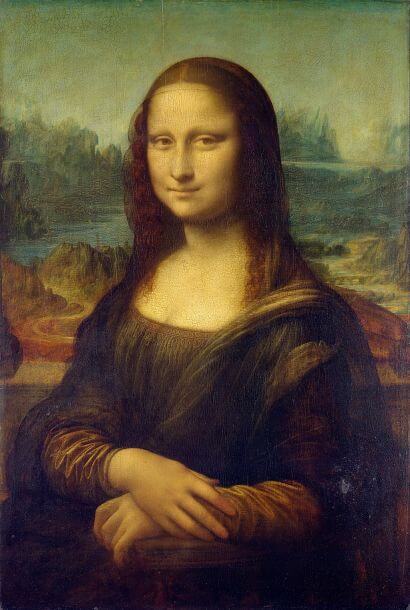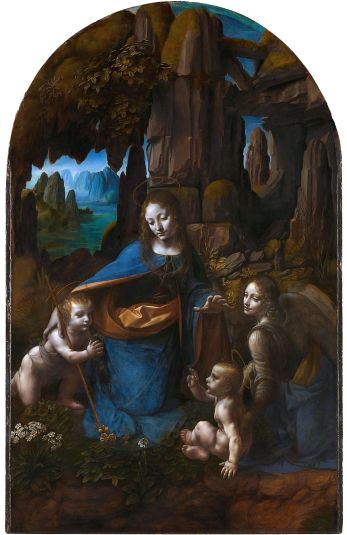|
Where? Room 35 of the Uffizi Museum
When? 1472-1475 Commissioned by? Unknown What do you see? Mary sits on a paved terrace in front of a palace-like building and is reading at a richly decorated desk carved from marble. She gets surprised by a visit of the youthful Archangel Gabriel, who explains to her that she will be the mother of the Son of God. Gabriel raises his right hand to greet Mary and holds a white lily in his left hand. Mary hesitantly raises her left hand to greet the angel. The landscape in the back shows mountains, a sea, and cypresses, all typical elements present in the paintings of Leonardo da Vinci. All perspectives – height, width, and depth – converge on Mary, making her the center of attention. Interestingly, the desk of Mary and the palace-like building seem somewhat out of place in this setting, and the figures of Mary (who is usually described as a simple woman) and Gabriel seem to fit better with the bed of flowers and the nature-like background. Backstory: This painting has been in the Uffizi since 1867. Before that it hung in the San Bartolomeo at Monte Oliveta Church in the countryside of Tuscany. There has been a constant debate on who painted this work. The consensus is now that this painting was created in the workshop of Andrea del Verrocchio. A popular explanation is that the painting was started by Andrea del Verrocchio, who left a note to his pupil Leonardo da Vinci to finish the painting. This painting is now considered by many to be Leonardo’s first major work, as he made the background, the wings of the angel, and the finishing touches to the painting. The painting is based on Luke 1: 26-38, where the Archangel Gabriel foretells the birth of Jesus to Mary. Symbolism: The angel holds a Madonna lily in his left hand. This lily represents the purity of Mary and is also the symbol of the city of Florence. Mary can be identified by her dress which is largely blue. The enclosed garden in which Gabriel is kneeling is a symbol of Mary’s virginity. The marble desk or sarcophagus in the middle has been painted after the tomb of Piero and Giovanni de’ Medici which was carved by Verrocchio.
Who is Mary? The Virgin Mary has been the most popular subject in Christian art. She represents four Roman Catholic dogmas, which are at the basis of Catholicism: Perpetual Virginity (when she gave birth to Jesus), Mother of God, Immaculate Conception (Mary was already without sins in the womb of her mother), and the Assumption into Heaven at the end of her life.
Why the Annunciation? The ‘Annunciation’ has already been the subject of art since the fourth century. It has been a very popular theme in Florentine art. It shows the moment that the Archangel Gabriel tells the Virgin Mary that she will give birth to the Son of God. Who is Leonardo da Vinci? Leonardo da Vinci (1452-1519) was an architect, astronomer, engineer, inventor, mathematician, musician, painter, writer, and much more. He is known to be one of the biggest multi-talents the world has ever seen. The fact that he studied science and nature extensively helped him in his artwork. He has produced a large number of sketches in which he practiced to draw specific human features, such as hand gestures, facial expressions, bone structures, and other anatomical features. Some of his most famous paintings include the Mona Lisa in the Louvre and the Virgin of the Rocks of which one version is in the Louvre and another version in the National Gallery in London.
Fun facts: The wings of the Archangel Gabriel are painted by Leonardo da Vinci and are most likely copied from a bird in flight. However, if you look carefully, these wings have been extended later on by another unknown artist.
People have also noticed some rookie mistakes in this painting, indicating that the young Leonardo was still mastering the tricks of perspective. For example, look at the right hand of Mary, which rests on the reading desk. The desk is closer to the viewer than Mary. However, that makes it strange that Mary’s right hand is on the left side of the reading desk. In other words, her right hand is too close to the viewer compared to the rest of her body. Finally, the painting lacks some of the emotions in the faces of the angel and Mary. But Da Vinci would learn over time how to include these emotions, which is clearly visible in his Mona Lisa. Interested in a copy for yourself? Poster
Written by Eelco Kappe
References:
6 Comments
molly
1/22/2018 10:10:42 am
how much would the real painting cost to purchase it?
Reply
1/22/2018 01:28:24 pm
This is difficult to say for a few reasons. First, there are not many surviving paintings of Da Vinci. So, it is hard to compare to prior Da Vinci sales. Salvator Mundi was expected to sell for about $100 million but sold for $450 million. Second, the painting is already for 150 years in the Uffizi and has not been on the market for even longer. Third, the Uffizi has never considered selling this painting so I did not come across any estimates on its value.
Reply
While learning from my guide in the Uffizi, I was told the 'mistakes' aren't truly mistakes made by Leonardo. Mary's right arm, for example, is intentionally extended. Why? Because you're not supposed to view the painting straight on, but rather from a lower angle to the right. This painting was supposed to have once graced a side altar in the church of San Bartolomeo a Monteoliveto in Florence, which da Vinci took account of. Another mistake: the center. Usually, we want to have the center be the focus of attention. The rank of 'art work' was Religious & Historical (ranked highest in importance) to Landscapes & Still Life (ranked insignificant). It doesn't make sense to have a landscape in the center, let alone have it quite plain and open. The reason for this is again: perspective. If you were to see the painting in person, you'd be able to see that if you saw it from the right, the center of the painting (due to anamorphosis) becomes Mary's table rather than the landscape.
Reply
TripImprover
12/12/2018 12:09:58 pm
Thank you for this clarification! This is very interesting and your arguments certainly make sense.
Reply
bob miller
2/4/2019 01:31:56 am
how did people react to this painting when it was first painted?
Reply
TripImprover
2/9/2019 09:45:06 am
Good question! What I know is the commissioner of this work is unknown. Given the size of the painting, it was likely some monastery or church, but could also be an individual. In the latter case, few people would have seen it.
Reply
Leave a Reply. |
Categories
All
|
- Home
- Blog
-
Museums
- Alte Pinakothek
- Art Institute of Chicago
- Baltimore Museum of Art
- Barber Institute of Fine Arts
- Bargello
- Barnes Foundation
- British Museum
- Church of Sant’Anastasia
- Cleveland Museum of Art
- Courtauld Institute of Art
- Detroit Institute of Arts
- Frans Hals Museum
- Galleria Borghese
- Gallerie dell'Accademia
- Getty Museum
- Guggenheim
- Hermitage Museum
- Kunsthistorisches Museum
- Kunstmuseum Basel
- Legion of Honor Museum
- Louvre
- Mauritshuis
- Metropolitan Museum of Art
- Musee d’Orsay
- Museum of Fine Arts in Boston
- Museum of Modern Art
- National Gallery in London
- National Gallery of Art
- National Museum in Poznań
- Norton Simon Museum
- Ny Carlsberg Glyptotek
- Palace of Versailles
- Palazzo Pitti
- Palazzo Vecchio
- Petit Palais
- Philadelphia Museum of Art
- Prado
- Pushkin Museum
- Ravenna Art Museum
- Rijksmuseum
- San Diego Museum of Art
- Santa Maria delle Grazie
- St. Peter's Basilica
- Städel Museum
- Statens Museum for Kunst
- Tate Britain
- Tate Modern
- Timken Museum of Art
- Uffizi
- Vatican Museums
- Wallace Collection
-
Artists
- Altdorfer
- Anguissola
- Berlin Painter
- Bosch
- Botticelli
- Boucher
- Bronzino
- Bruegel the Elder
- Brunelleschi
- Cabanel
- Caillebotte
- Canova
- Caravaggio
- Carpeaux
- Cezanne
- Cimabue
- David
- Degas
- Delacroix
- De Maria
- Donatello
- El Greco
- Fontana
- Fra Angelico
- Fragonard
- Gauguin
- Gentileschi
- Gericault
- Gonzalez-Torres
- Goya
- Hals
- Hogarth
- Hokusai
- Ingres
- Leonardo da Vinci
- Lippi, Filippo
- Longhi, Barbara
- Lorrain
- Makovsky
- Manet
- Massys
- Matisse
- Merian
- Michelangelo
- Mochi
- Modigliani
- Monet
- Panini
- Parmigianino
- Perugino
- Picasso
- Pisanello
- Raphael
- Rembrandt
- Renoir
- Reynolds
- Rivera
- Rodin
- Rubens
- Scultori
- Seurat
- Steen
- Tintoretto
- Titian
- Toulouse-Lautrec
- Turner
- Uccello
- Van der Weyden
- Van Dyck
- Van Eyck
- Van Gogh
- Van Hemessen
- Vasari
- Velazquez
- Vermeer
- Veronese
- Vigée Le Brun
-
Locations
- Books
- About Us

